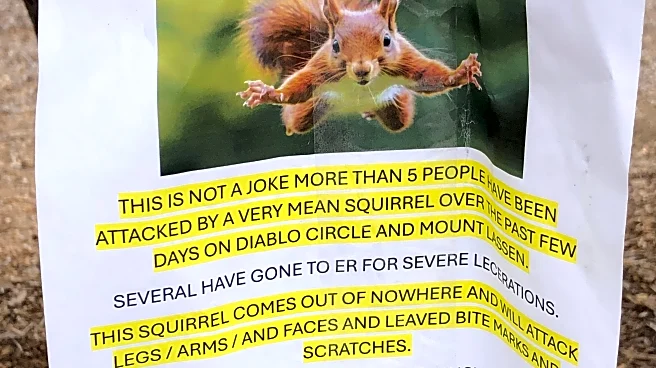What's Happening?
In San Rafael, California, a squirrel has been causing alarm among residents by attacking individuals, leading to at least two people requiring emergency medical care. The aggressive behavior of the squirrel is believed to be a result of human interaction, specifically being fed by people when it was younger. This has led the animal to associate humans with food, causing it to approach and bite people. The incidents have been reported by local residents, including Joan Heblack and Isable Campoy, who described sudden and unexpected attacks during their walks. Experts from WildCare, a local wildlife hospital, have noted that such behavior is not uncommon when animals are hand-fed by humans and later struggle to forage independently.
Why It's Important?
The situation highlights the unintended consequences of human interaction with wildlife, particularly the feeding of wild animals. This behavior can lead to animals becoming overly familiar with humans, resulting in aggressive encounters when they seek food. The attacks have raised concerns about public safety and the need for better education on wildlife interaction. Organizations like Marin Humane emphasize the importance of not feeding wild animals to prevent such incidents. The community's response and the potential need for intervention to remove the squirrel underscore the broader issue of human-wildlife conflict in urban areas.
What's Next?
Local authorities and wildlife organizations may need to take action if the squirrel continues to pose a threat to residents. This could involve capturing and relocating the animal to a more suitable environment. Additionally, there may be increased efforts to educate the public on the risks of feeding wildlife and the importance of maintaining a safe distance from wild animals. Monitoring the situation will be crucial to ensure the safety of both residents and the squirrel.
Beyond the Headlines
The incident serves as a reminder of the delicate balance between urban development and wildlife habitats. As cities expand, interactions between humans and wildlife are likely to increase, necessitating more comprehensive strategies to manage these encounters. Ethical considerations also arise regarding the treatment and relocation of wild animals that have become problematic due to human actions.











